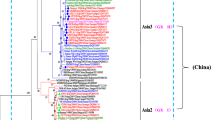Abstract
Molecular genetic analysis of the rabies virus strain Moscow 3253 genome adapted to Vero cells. The isolated cDNA was specifically enriched with the nucleotide sequence of the target virus genome using amplification. Whole genome sequencing was performed on the Ion PGM platform and additionally using the AB 3500xl genetic analyzer. Alignment and assembly of sequences into a complete genome and further analysis were performed using DNASTAR Lasergene 11.2 and MEGA 7. Phylogenetic analysis was carried out using 479 rabies virus genomes represented in the NCBI GenBank database. The dendrogram was constructed using the BioNumerics 7.6 software package. The genome of the rabies virus Moscow 3253 (Vero) has been deposited into NCBI GenBank (accession MF630920). The genome of the rabies virus Moscow 3253 (Vero), as compared to its original variant, has 1069 single mutations. Its phylogenetic closeness to various vaccine variants of the rabies virus genome represented in the NBCI GenBank database, which are also adapted to the Vero or BHK cell culture, has been established. A strong influence of the Vero cell culture as a reproduction medium for the rabies virus Moscow 3253 (Vero) on the acquisition of a large number of single mutations by its genome has been revealed. As has been stated in a previously published work, the physicochemical and biological properties of rabies immunoglobulin (RIG) obtained by the technology using the rabies virus strain Moscow 3253 (Vero) meet the requirements of the regulatory documentation for RIG. Thus, the use of the rabies virus adapted to the Vero cells for the production of a rabies vaccine is promising.


Similar content being viewed by others
REFERENCES
WHO Expert Consultation on Rabies: First Report. WHO Technical Report Series 931, Geneva, 2004.
Selimov, M.A., Beshenstvo (Rabies), Moscow: Meditsina, 1978.
Generalov, S.V., Abramova, E.G., Matveeva, Zh.V., Zhulidov, I.M., Lobovikova, O.A., Svintsov, R.A., et al., Culture antigen in the technology of producing rabies immunoglobulin from horse serum, Probl. Partic. Dangerous Infect., 2012, vol. 4, no. 114, pp. 65–68. https://doi.org/10.21055/0370-1069-2012-4-65-68
Generalov, S.V., Abramova, E.G., Matveeva, Zh.V., Zhulidov, I.M., and Svintsov, R.A., Large scale cultivation of a fixed rabies virus strain “Moscow 3253” on Vero (B) cell line: methods and comparative analysis, Biotechnology, 2014, vol. 5, pp. 38–43.
Podchernyaeva, R.Ya., Khizhnyanova, T.M., and Mikhailova, G.R., Vero (B) cell line for the preparation of biomedical drugs, Probl. Virol., 1996, vol. 4, pp. 183–185.
Metlin, A., Paulin, L., Suomalainen, S., Neuvonen, E., Rybakov, S., Mikhalishin, V., et al., Characterization of Russian rabies virus vaccine strain RV-97, Virus Res., 2008, vol. 132, pp. 242–247. https://doi.org/10.1016/j.virusres.2007.11.016
Murphy, F.A. and Nathanson, N., The emergence of new virus diseases: an overview, Semin. Virol., 1994, vol. 5, pp. 87–102. https://doi.org/10.1006/smvy.1994.1010
Yang, J., Koprowski, H., Dietzschold, B., and Fu, Z.F., Phosphorylation of rabies virus nucleoprotein regulates viral RNA transcription and replication by modulating leader RNA encapsidation, J. Virol., 1999, vol. 73, pp. 1661–1664. PMID 9882376
Brzozka, K., Finke, S., and Conzelmann, K.K., Identification of the rabies virus alpha/beta interferon antagonist: Phosphoprotein P interferes with phosphorylation of interferon regulatory factor 3, J. Virol., 2005, vol. 79, pp. 7673–7681. https://doi.org/10.1128/JVI.79.12.7673-7681.2005
Chenik, M., Chebli, K., Gaudin, Y., and Blondel, D., In vivo interaction of rabies virus Phosphoprotein (P) and nucleoprotein (N), existence of two N binding sites on P protein, J. Gen. Virol., 1994, vol. 75, pp. 2889–2896. https://doi.org/10.1099/0022-1317-75-11-2889
Fu, Z.F., Zheng, Y., Wunner, W.H., Koprowski, H., and Dietzschold, B., Both the N- and the C-terminal domains of the nominal phosphoprotein of rabies virus are involved in binding to the nucleoprotein, J. Virol., 1994, vol. 200, pp. 590–597. https://doi.org/10.1006/viro.1994.1222
Sissoeff, L., Mousli, M., England, P., and Tuffereau, C., Stable trimerization of recombinant rabies virus glycoprotein ectodomain is required for interaction with the p75NTR receptor, J. Gen. Virol., 2005, vol. 86, pp. 2543–2552. https://doi.org/10.1099/vir.0.81063-0
Nakahara, T., Toriumi, H., Irie, T., Takahashi, T., Ameyama, S., Mizukoshi, M., et al., Characterization of a slow-migrating component of the rabies virus matrix protein strongly associated with the viral glycoprotein, Microbiol. Immunol., 2003, vol. 47, pp. 977–988. https://doi.org/10.1111/j.1348-0421.2003.tb03458.x
Evans, J.S., Selden, D., Wu, G., Wright, E., Horton, D.L., Fooks, A.R., et al., Antigenic site changes in the rabies virus glycoprotein dictates functionality and neutralizing capability against divergent lyssaviruses, J. Gen. Virol., 2018, vol. 99, no. 2, pp. 169–180. https://doi.org/10.1099/jgv.0.000998
Tuchkov, I.V., Krasnov, Ya.M., Goryaev, A.A., Matveeva, Zh.V., Stepanov, A.V., Maiorov, N.V., et al., Nucleotide sequence and phylogenetic analysis of G glycoprotein of the rabies virus strain “Moscow 3253” from Russia, Probl. Partic. Dangerous Infect., 2013, no. 4, pp. 73–75. https://doi.org/10.21055/0370-1069-2013-4-73-75
Funding
The authors declare that they have no funding for this work.
Author information
Authors and Affiliations
Corresponding author
Ethics declarations
The authors declare that they have no conflict of interest. This article does not contain any studies involving animals or human participants performed by any of the authors.
Additional information
Translated by M. Novikova
ADDITIONAL INFORMATION
Krasnov Ya.M.—https://orcid.org/0000-0002-4909-2394; e-mail: rusrapi@microbe.ru
Alkhova Zh.V.—https://orcid.org/0000-0001-7681-5773
Generalov S.V.—https://orcid.org/0000-0003-1461-5383
Tuchkov I.V.—https://orcid.org/0000-0003-0712-8659
Naryshkina E.A.—https://orcid.org/0000-0002-9190-099X
Sharapova N.A.—https://orcid.org/0000-0002-5289-7783
Abramova E.G.—https://orcid.org/0000-0002-8798-1547
Supplementary Information
About this article
Cite this article
Krasnov, Y.M., Alkhova, Z.V., Generalov, S.V. et al. Whole Genome Sequencing and Phylogenetic Analysis of the Rabies Virus Strain Moscow 3253 Adapted to a Vero Cell Line. Mol. Genet. Microbiol. Virol. 35, 237–242 (2020). https://doi.org/10.3103/S0891416820040060
Received:
Revised:
Accepted:
Published:
Issue Date:
DOI: https://doi.org/10.3103/S0891416820040060




